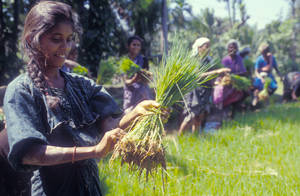From FAO
Tools to help fight hunger and to improve food systems – FAO symposium
Opening the FAO-hosted international symposium “The Role of Agricultural Biotechnologies in Sustainable Food Systems and Nutrition”, Graziano da Silva stressed the need for “a broad portfolio of tools and approaches to eradicate hunger, fight every form of malnutrition and achieve sustainable agriculture.”
“As a neutral forum, FAO has been promoting debates, dialogues and exchanges of information in order to enhance our knowledge of these tools and approaches,” the FAO Director-General added.
The symposium focuses mainly on the broad range of biotechnologies that could result in yield increases, better nutritional qualities, and improved productivities of crops, livestock, fish and trees benefitting family farmers and their food systems, nutrition and livelihoods.
These include many “low tech” applications, for example fermentation processes, bio-fertilizers, artificial insemination, the production of vaccines, disease diagnostics, the development of bio-pesticides and the use of molecular markers in developing new varieties and breeds.
“We cannot lose sight that biotechnologies, knowledge and innovation must be available, accessible and applicable to family farmers including small holders,” Graziano da Silva told symposium participants. “We must find the means to remove the barriers that prevent their availability to family farmers,” he added.
“Let me state this loud and clear: this symposium is not about genetically modified organisms (GMOs). Agricultural biotechnologies are much broader than GMOs,” the FAO Director underscored.
About 500 scientists, representatives of government, civil society, the private sector, academia, farmers’ associations and cooperatives are participating in the three day event. A high-level ministerial segment will take place on 16 February.
Ahead of the symposium, FAO issued a worldwide public call of interest to ensure the broadest possible range of participants. All non-state actors were given equal space, and they responded according to their interests.
Sharing knowledge, experience and best practices
Through a series of presentations and side events, symposium participants will share knowledge, experience and best practices on how biotechnologies can help to make the transition from agricultural production that relies of fewer inputs with less negative impacts. Several success stories will be discussed. Examples of these – none of which involve GMOs – can be found here.
“We want to investigate and give examples of how modern biotechnologies can be compatible with principles of agroecological approaches,” Graziano da Silva said, noting that knowledge and innovation “grounded on sound evidence and science” are key to address the complex challenges of sustainable agriculture.
The symposium is planned around three main themes: climate change impacts; sustainable food systems and nutrition; and, people, policies, institutions and communities.
It also includes a special student interactive session to provide an opportunity for the young generation to listen to symposium speakers and to present their views. Students from five agricultural universities around the world will hold live webinars through video links with FAO headquarters in Rome.
As part of its efforts to promote international dialogues and exchanges of information on sustainable development FAO in 2014 organized an international symposium on agroecology and also helped launch the Global Alliance on Climate Smart Agriculture. In January this year it released a new edition of “Save and Grow in Practice” FAO’s model for ecosystem-based agriculture.
Source: http://goo.gl/lblzXc


